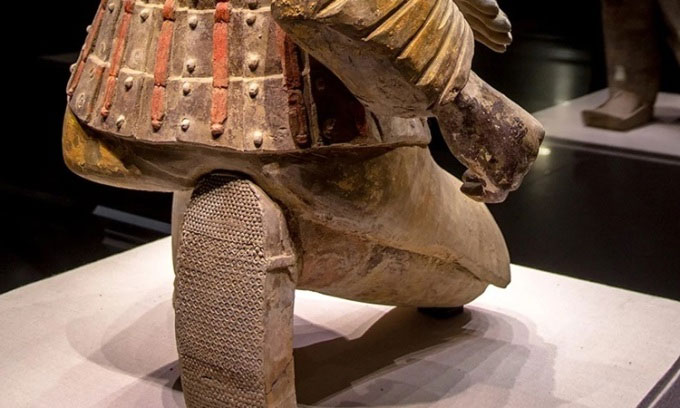Special shoes of the terracotta warrior tomb of Qin Shi Huang
The shoes on the feet of an archer in the terracotta army have many superior features, demonstrating the excellent level of craftsmanship during the Qin Dynasty .
50 years after its discovery, China's famous terracotta army is gradually revealing its secrets. Since being found by chance by a group of farmers digging a well, the life-sized terracotta statues provide many fascinating details about the soldiers of the Qin Dynasty, the dynasty that first unified China in 221 AD. BC under the reign of Emperor Qin Shi Huang. The results of detailed examination of terracotta warriors in burial pits near the emperor's mausoleum in northeastern Xi'an help researchers learn about ancient life during the Qin Dynasty, from the soldiers' costumes to their backgrounds. , according to the BBC .

The sole of the terracotta warrior's shoe. (Photo: BBC).
Shoes are not the first item to attract attention in 2,200-year-old statues armed with real weapons and arranged in military formation to protect Qin Shi Huang in the afterlife. But preliminary analysis results show that this modest accessory may have played an important role in the Qin army, helping them win victories.
Two Chinese researchers analyze the shoes of a kneeling archer statue, the only terracotta warrior excavated with the sole exposed to date. They then created a replica of the shoes using the shoemaking techniques and materials that people of the Qin Dynasty used at the time of making the terracotta warriors. The study compared the reconstructed shoes with two modern shoes and found that the replicas were extremely flexible and provided users with a more comfortable, stable and efficient walking experience. The sole of the shoe is also more resistant to slipping in wet conditions.
According to Cha Na, a PhD student at the School of Biomass Science and Engineering at Sichuan University in Chengdu, the shoe manufacturing process is unique with excellent craftsmanship. What surprised Father the most was that the sole of the shoe consisted of many layers woven from silkworm tree fibers glued, sewn and tightly packed together. "When holding a modern replica of shoes that Qin Dynasty soldiers may have worn more than 2,000 years ago, I was extremely impressed by its sophistication ," Father shared. "I can imagine the needles going through the multi-layered shoe sole, creating neat stitching lines. The shoe sole is extremely soft and comfortable, and can bend easily."
The sole of the kneeling warrior's shoe is divided into 3 parts, each part has a different number of stitching holes. The toe part has the densest number of stitching holes, followed by the heel and the sole of the foot. This design is also reflected in the research team's copy. According to them, this detail is based on the user's needs, aiming to provide optimal comfort, support and durability. Absorbent material used in the heels also helps soldiers in wet conditions. Anti-slip shoes allow them to move firmly on difficult terrain.
To date, researchers have only excavated about 2,000 terracotta warrior statues, although more and more are found every year. It may take a long time to excavate all the warrior statues, according to Chinese archaeologists. They will continue to reveal new information about life in ancient Chinese society during the Qin Dynasty. Clearly, the skill and craftsmanship of their creators was no less remarkable than the military power the army represented.
- New discovery of terracotta army in the tomb of Qin Shihuang
- New theory about terracotta army Qin Shihuang
- The deadly weapon of the terracotta army, the tomb of Qin Shi Huang
- Why hasn't China dared to excavate the tomb of Qin Shui Huang?
- The mystery of the tomb Qin Shihuang
- China suspended excavation of the tomb of Qin Shi Huang
- Detecting a concussion about the terracotta army in the tomb of Qin Shi Huang
- Why are the weapons in the 2,000-year-old Qin Shi Huang tomb still shiny?
- Find the culprit who burned the tomb of Tan Thuy Hoang
- Image: Excavating hundreds of 2000-year-old warriors
- 3 times Qin Shi Huang's terracotta army 'revived': Every time it appeared, it shook public opinion
- Excavating the tomb of Qin Shui Huang, discovering the animal world inside
 Discovered an ancient centipede fossil 99 million years old
Discovered an ancient centipede fossil 99 million years old Discovered bat-like dinosaurs in China
Discovered bat-like dinosaurs in China Discovered a 200-year-old bronze cannon of the coast
Discovered a 200-year-old bronze cannon of the coast Discover 305 million-year-old spider fossils
Discover 305 million-year-old spider fossils